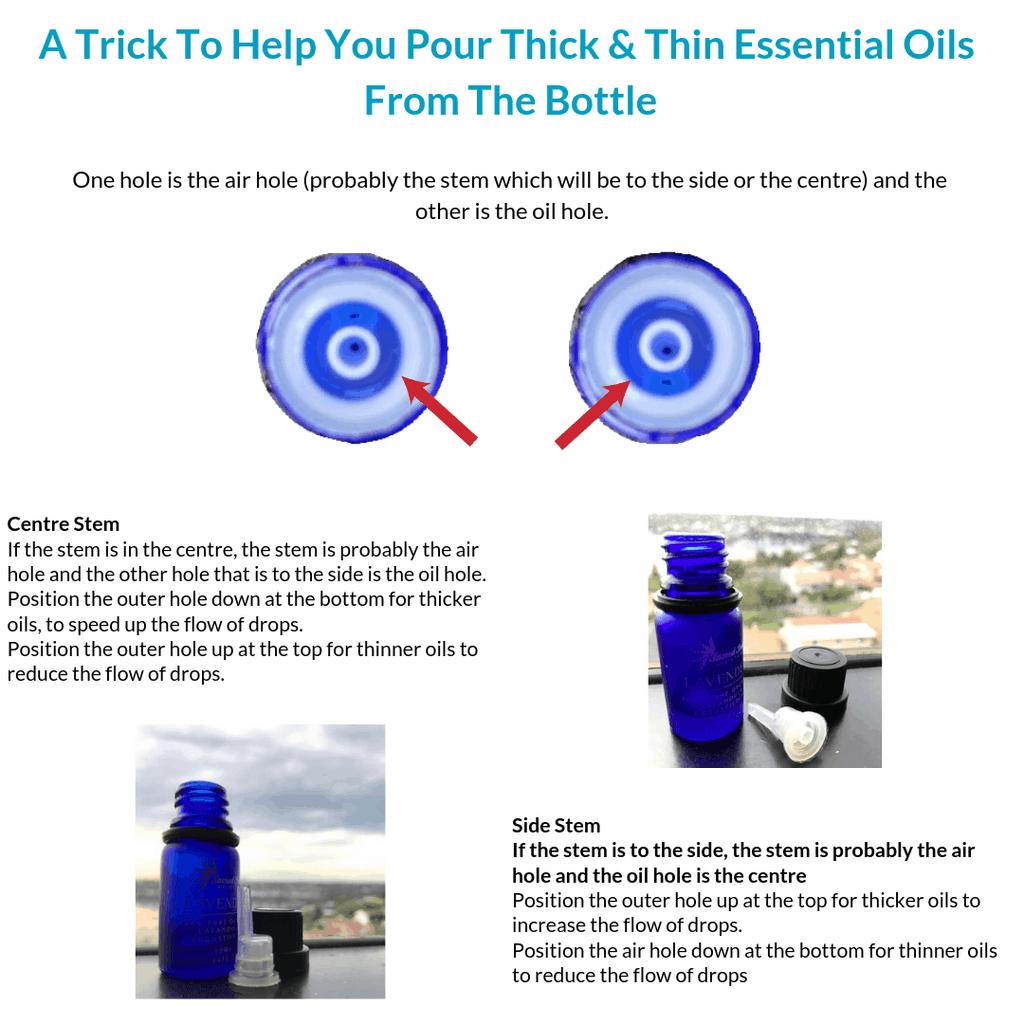How To Pour Thick And Thin Essential Oils From The Bottle Effectively

You may have noticed that essential oils vary in viscosity, or in other words, in how thick or thin they are.
Orifice reducers (also referred to as dripolators) is the name given to the insert that you see inside of the bottle that helps to control the rate at which the oil comes out.
Although there is slight variations in orifice reducers, overall they tend to be of a similar size and don't really account for the varying consistencies of the different oils.
This is why it might sometimes seem like the really thin oils (e.g. citrus oils and eucalyptus) race out of the bottle in a stream of drops so fast that it's like a continuous flow. Thick oils (e.g. vetiver and patchouli) on the other hand, can often take a long time to come out of the bottle one drop at a time, even if the bottle is held completely upside down.
But did you know there is a little technique that can help with this?
Instructions
- Remove the cap from your bottle of essential oil and have a close look at the orifice reducer from above
- You should see the middle hole which is what you'd probably expect... but if you look a little closer, you should see another hole. The oil comes out from one of these holes and the other hole is an air hole. The stem is usually the air hole and the position of the stem, whether to the side or centre, affects the best way to pour thick or thin essential oils
-
If you hold your bottle of essential oil up to the light, the average eye will probably be able to see whether the stem of the orifice reducer is in the centre or to the side
-
If the stem is in the centre, the stem is probably the air hole and the other hole that is to the side is the oil hole.
- Position the outer hole down at the bottom for thicker oils, to speed up the flow of drops. The oil hole at the bottom means it is below the oil level while the air hole is above the oil level improving the air flow
- Position the outer hole up at the top for thinner oils to reduce the flow of drops. The oil hole at the top and the air hole at the bottom, means the opposite to the above happens therefore slowing down the flow of oil from the bottle.
-
If the stem is to the side, the stem is probably the air hole and the oil hole is the centre
- Position the outer hole up at the top for thicker oils to increase the flow of drops. Having the air hole at the top allows the air to move more freely which helps the thick oil to flow
- Position the air hole down at the bottom for thinner oils to reduce the flow of drops. This position means the air can't flow as freely so it slows the flow of drops coming out of the bottle
-
If the stem is in the centre, the stem is probably the air hole and the other hole that is to the side is the oil hole.
- The image in this post shows examples, but note that the orifice reducer is subject to change with any brand, including the position of the stem, so always check this whenever you receive a new bottle
-
With thin oils especially, even with the air hole at the top, still be sure to very slowly and carefully, turn the bottle on its side until the oil begins to come out
- Also note that if you had a blockage in your bottle that suddenly clears, the oil will more than likely pour out quickly. To help prevent this, every time you go to use your oil, make a habit of gently tapping the bottle before you slowly turn it to pour
Hope this helps! :)
P.S If you are struggling to see the little hole, turn the bottle on its side and gently roll it until a drop comes out. The drop will probably come out from the tiny space around the centre as you gently tip the bottle. The rolling of the bottle lets a drop out of the bottle when the air flow is aligned which should help if you can't see a tiny hole.

